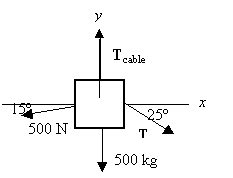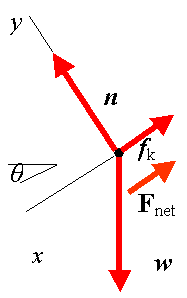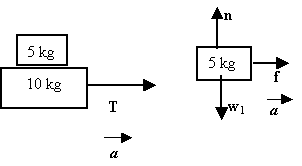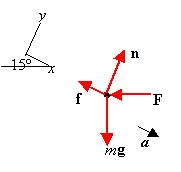
As the piano is moving steadily, we have
SFx = Tcos25° - (500 N)cos15° = 0, which gives T = 533 N.
b. SFx = Tcable - (500 kg)(9.8m/s2) - (500 N)sin15° - (533 N)sin25° = 0, which gives Tcable = 5.26 x 103 N.
F = ma;
2.0 N = (0.050kg)a, a = 40 m/s2.
We find the velocity of the ball on the top of the tube.
v2 = v02 + 2ay = 0 + 2(40 m/s2)(1.0 m) = 80 m2/s2, v = 8.94 m/s.
We find the distance the ball go high in the air from the top of the tube.
v2 = v02 - 2ay;
0 = (8.94 m/s)2 - 2 (9.8m/s2)y, y = 4.44 m.
| Choose the coordinate system as shown. SFx = -f + mgsinq = max. SFy = n - mgcosq = 0. We have f = mn = mmgcosq , substitute f into x-equation to find ax. ax = mg(sinq - mkcosq)/m = g(sinq - mkcosq) = (9.8m/s2)[sin20° - (0.5)cos20°] = -1.25m/s2. Find the initial speed from v2 = v02 + 2 axx; 0 = v02 + 2 (-1.25m/s2)(3.5 m), v0 = 2.96m/s. |
 |
We draw the free-body diagrams for sled and the box as shown.
| For the sled and box: T = (m1 + m2)a, a = T/(m1 + m2) For the box: SFx = f = mkn = m1a; SFy = n - w1 = 0, n = w1 = m1g, So f = mkm1g. To prevent the box from sliding, f = mkm1g > m1a = m1T/(m1 + m2), Or T < (m1 + m2)mkg = (5 kg + 10 kg)(9.8m/s2)(0.2) = 29.4 N. |
 |
| We choose the coordinate system as shown. SFx = -f - Fcosq + mgsinq = max. SFy = n - mgcosq = 0. So, ax = [mgsinq - mkmgcosq - Fcosq]/m = [(75 kg)(9.8m/s2)sin15° - mk(75 kg)(9.8m/s2)cos15° - (50 N)cos15°]/(75 kg) > 0. When ax = 0, mk = 0.19992. so the best wax is green with mk = 0.15 < 0.19992. |
 |